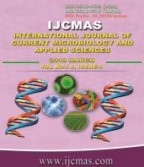


 National Academy of Agricultural Sciences (NAAS)
National Academy of Agricultural Sciences (NAAS)

|
PRINT ISSN : 2319-7692
Online ISSN : 2319-7706 Issues : 12 per year Publisher : Excellent Publishers Email : editorijcmas@gmail.com / submit@ijcmas.com Editor-in-chief: Dr.M.Prakash Index Copernicus ICV 2018: 95.39 NAAS RATING 2020: 5.38 |
Very few therapeutic options are available from the time of emergence of MRSA. Macrolide lincosamide streptogramin B (MSLB) antibiotics can be used in such scenarios with clindamycin being the preferred agent due to its excellent pharmacokinetic properties. Staphylococcal resistance to clindamycin may be inducible (iMLSB - inducible Macrolide-Lincosamide Streptogramin B resistance) or constitutive. The treatment of patients harbouring iMLSB Staphylococci with clindamycin leads to the development of constitutive resistance, subsequently leading to therapeutic failure. If inducible Clindamycin resistance can be reliably detected by placing relevant disc adjacent to each other at proper distance as a routine basis in clinically significant isolates, Clindamycin can be safely and effectively used in patients with true Clindamycin susceptible strains. Objective of the study is to determine prevalence of inducible clindamycin resistance in S.aureus. 100 Staphylococcus aureus isolates collected from various clinical samples were subjected to routine antibiotic susceptibility testing and screening for Methicillin Resistance was done as per CLSI guidelines. Detection of inducible clindamycin resistance was done using Double disk diffusion test or D test. Out of 100 S. aureus (88 MRSA, 12 MSSA) isolates, prevalence of inducible clindamycin resistance was found to be 39% (39 isolates). Inducible Clindamycin resistance was found to be higher in MRSA 40.9% (36 MRSA isolates) as compared to MSSA 25% (3 MSSA isolates). We conclude that whenever clindamycin is intended for S. aureus infection, the microbiology lab should tests the isolated organism for iMLSB by D test.
 |
 |
 |
 |
 |